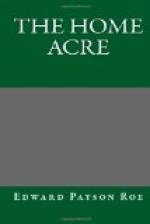Moreover, it should be remembered that few evergreens will thrive in a wet, heavy soil. If Nature has not provided thorough drainage by means of a porous subsoil, the work must be done artificially. As a rule, light but not poor soils, and warm exposures, are best adapted to this genus of trees.
I think that all authorities agree substantially that spring in our climate is the best time for the transplanting of evergreens; but they differ between early and advanced spring. The late Mr. A. J. Downing preferred early spring; that is, as soon as the frost is out, and the ground dry enough to crumble freely. Mr. A. S. Fuller indorses this opinion. Mr. Josiah Hoopes, author of a valuable work entitled “The Book of Evergreens,” advises that transplanting be deferred to later spring, when the young trees are just beginning their season’s growth; and this view has the approval of the Hon. Marshall P. Wilder and Mr. S. B. Parsons, Jr., Superintendent of City Parks. Abundant success is undoubtedly achieved at both seasons; but should a hot, dry period ensue after the later planting—early May, for instance—only abundant watering and diligent mulching will save the trees.
It should be carefully remembered that the evergreen families do not possess the vitality of deciduous trees, and are more easily injured or killed by removal. The roots of the former are more sensitive to exposure to dry air and to sunlight; and much more certainty of life and growth is secured if the transfer can be accomplished in cloudy or rainy weather. The roots should never be permitted to become dry, and it is well also to sprinkle the foliage at the time of planting. Moreover, do not permit careless workmen to save a few minutes in the digging of the trees. Every fibrous root that can be preserved intact is a promise of life and vigor. If a nurseryman should send me an assortment of evergreens with only the large woody roots left, I should refuse to receive the trees.
What I have said in opposition to the transplanting of large trees applies with greater force to evergreens. Mr. Hoopes writes: “An error into which many unpracticed planters frequently fall is that of planting large trees; and it is one which we consider opposed to sound common-sense. We are aware that the owner of every new place is anxious to produce what is usually known as an immediate effect, and therefore he proceeds to plant large evergreens, covering his grounds with great unsightly trees. In almost every case of this kind the lower limbs are apt to die, and thus greatly disfigure the symmetry of the trees. Young, healthy plants, when carefully taken up and as properly replanted, are never subject to this disfigurement, and are almost certain to form handsome specimens.”




